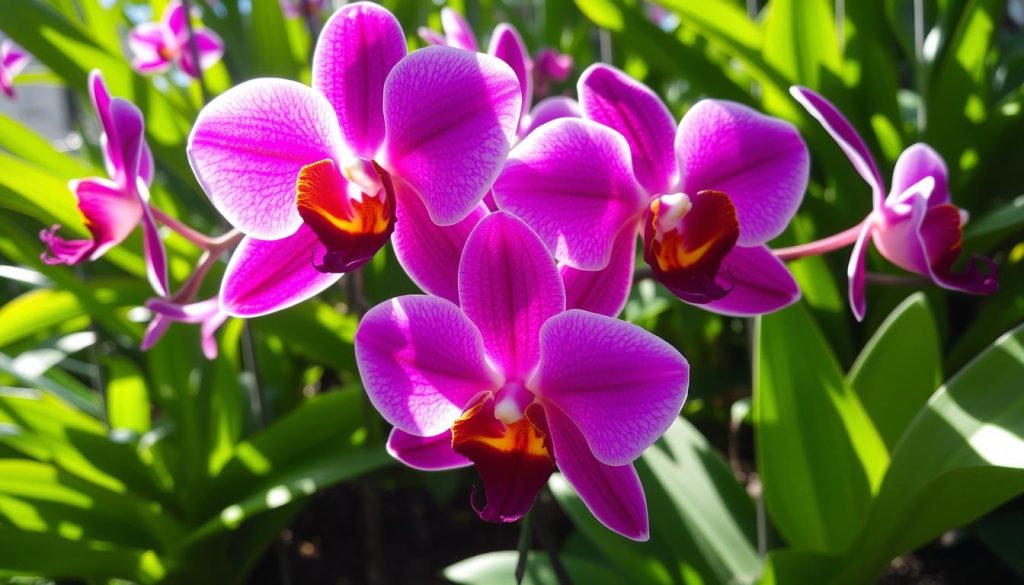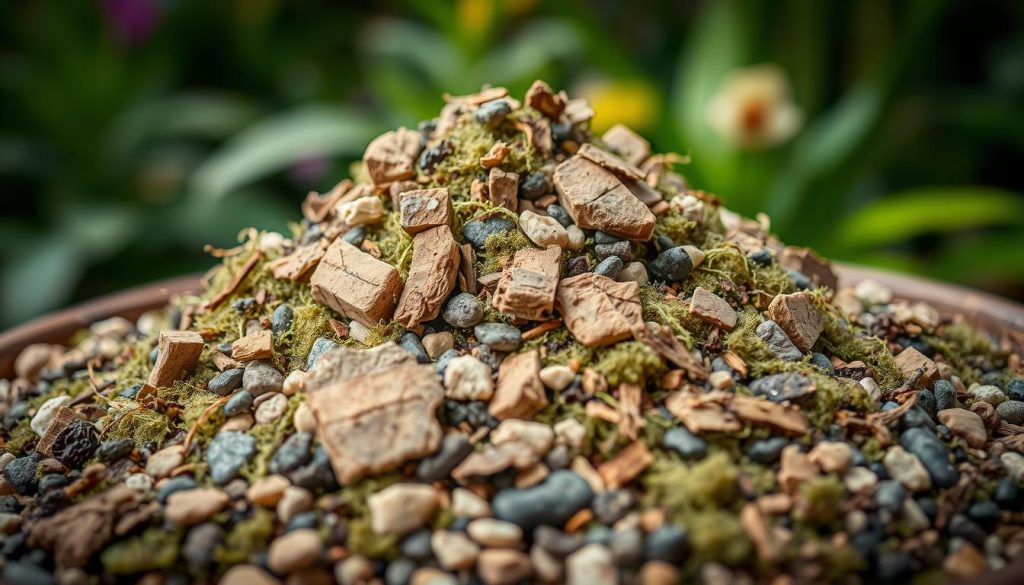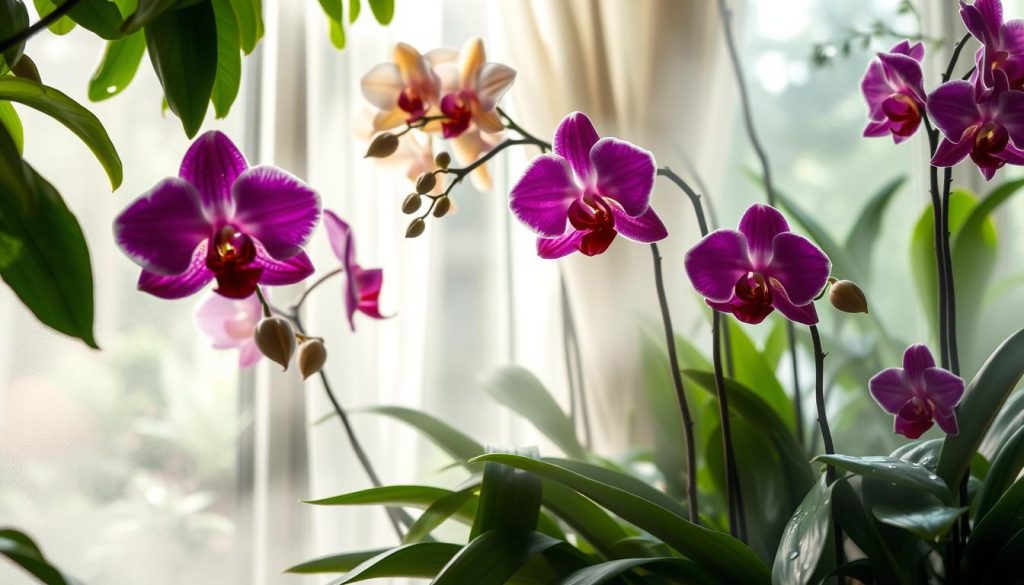Orchids are stunning indoor plants that can live up to 15 years with proper care. There are over 25,000 species, and the moth orchid (Phalaenopsis) is one of the easiest to grow. This guide will help you grow thriving orchids at home, whether you’re new to gardening or experienced.
Proper care for orchids includes the right light, soil, water, and fertilizer. One big challenge is overwatering. So, it’s key to water only when the soil is almost dry. Knowing the care needs of different orchids, like Phalaenopsis and Dendrobium, will help your plants bloom beautifully.

Key Takeaways
- Orchids are long-lived indoor plants with over 25,000 species, including the popular Phalaenopsis and Dendrobium varieties.
- Proper orchid care involves meeting specific light, soil, water, and fertilizer requirements to help them thrive.
- Avoiding overwatering is crucial, as it is one of the most common issues faced by orchid growers.
- Understanding the unique care needs of different orchid species can help ensure your plants bloom with vibrant, long-lasting flowers.
- With the right growing conditions, orchids can live for up to 15 years, making them a rewarding and long-lasting addition to any indoor garden.
Understanding Orchid Basics
Orchids are a diverse and captivating family of plants. They come in a wide range of species, adapted to various habitats around the world. From the delicate cymbidium to the bold epidendrum and the graceful oncidium, each orchid variety has unique characteristics and care requirements.
Types of Orchid Species
Some popular orchid species include the Phalaenopsis, known as the moth orchid, and the Vanda. The Oncidium, or dancing lady orchid, and the Cymbidium, or boat orchid, are also favorites. Each type has its own distinct features, growth patterns, and cultivation needs.
Natural Habitat and Growth Patterns
Orchids thrive in different natural environments, from tropical rainforests to temperate climates. Their growth patterns vary, with some species growing as epiphytes, clinging to trees or rocks. Others prefer to grow terrestrially in soil. Knowing the natural habitat and growth patterns of a specific orchid species is key to providing the ideal growing conditions.
Life Cycle of Orchids
Orchids have a fascinating life cycle, with some species living up to 10 to 15 years with proper care. From germination to bloom, orchids go through developmental stages, each needing specific conditions and care. Understanding the life cycle of orchids helps growers meet their needs better.
Essential Light Requirements for Healthy Orchids
Getting the right light is key for orchids to grow well and bloom. They need at least six hours of bright, indirect sunlight every day. Windows facing south or east are best because they give the right amount of light without too much sun.
The light needs of orchids vary by type. Some need as little as 1,000 foot-candles, while others prefer up to 5,000 foot-candles. Not enough light can stop them from blooming, so watch how they grow and move them if needed.
If your orchids don’t get enough natural orchid lighting, grow lights can help. These lights are made to give the same kind of light as the sun. Make sure to place them 1-2 feet above your plants and turn them on for the right amount of time.
Knowing what your orchids need in terms of indirect sunlight and grow light helps you create the best place for them to grow. This way, you can enjoy their beautiful flowers.
Temperature Control and Climate Considerations
Growing orchids needs careful temperature control. They come in cool-, intermediate-, and warm-growing types. Knowing their temperature needs is key to their health.
Daytime Temperature Requirements
Cool-growing orchids like Miltonia and Masdevallia do best in 60-70°F (15-21°C) during the day. Intermediate orchids need warmer days, between 70-80°F (21-27°C). Warm-growing orchids, such as Cymbidiums, prefer the hottest days, around 80-90°F (27-32°C).
Night Temperature Fluctuations
Most orchids need a cooler night. Cool-growing ones should drop to 50-55°F (10-13°C). Intermediate ones do well with 55-65°F (13-18°C) nights. Warm-growing ones like 65-70°F (18-21°C) at night.
Seasonal Temperature Adjustments
Orchids are sensitive to temperature changes. Adjusting their care with the seasons is crucial. In cold months, keep them at least 45°F (7°C) to avoid damage. As it warms up, raise the temperature to their preferred range. Keeping the right temperature all year helps them grow and bloom well.
Watering Techniques and Moisture Management
Proper watering is key for healthy orchid roots and avoiding overwatering. Orchids grow in bark chips or moss, needing just the right moisture. How often you water depends on temperature, light, potting mix, and the type of pot.
Water your orchids when the soil or mix is almost dry. A lighter pot means it’s time to water. Make sure not to let water sit in the crown or leaf joints, as it can cause rot and disease.
- Thin-leafed orchids need more water than thick-leaved ones.
- Dormant orchids drink less during their rest period.
- Soak the potting mix well, letting it almost dry before watering again.
- Watering in the morning helps prevent rot, as splashes can evaporate quickly.
Using the right orchid watering methods is vital for root health and avoiding overwatering. Knowing your orchids’ needs helps you create a watering schedule that keeps them healthy.
Ideal Growing Medium and Potting Solutions
Orchids need a special soil mix that drains well but holds water. A good mix has bark, peat, and perlite. This mix is perfect for these delicate plants.
Bark-Based Mixtures
Bark mixes, like fir or pine bark, are great for orchids. They drain well and keep moisture in. The bark’s size should fit the orchid’s roots for best air and nutrient uptake.
Drainage Requirements
Orchids need good drainage to avoid root rot. Adding perlite, lava rock, or crushed charcoal helps. These materials improve drainage and prevent water from pooling.
Repotting Guidelines
Repot orchids every 2-3 years or when the roots outgrow the pot. Remove the plant gently, untangle the roots, and put it in a slightly bigger pot with fresh orchid potting mix. This keeps the plant healthy and growing well.

Orchids: Popular Varieties and Their Characteristics
The world of orchids is vast, with over 25,000 species. From the elegant Vanda to the stunning Cattleya, each has unique traits. Knowing these can help you choose the right orchids for your space and taste.
The Phalaenopsis, or moth orchid, is loved for its long-lasting blooms. It prefers low to medium light and consistent watering. Oncidium orchids, known as “dancing lady” orchids, have vibrant flowers that last weeks.
Cymbidium orchids, or “boat orchids,” have large, showy blooms. They can grow up to 4 feet tall. Paphiopedilum, or slipper orchids, have unique flowers and need warm, humid conditions.
The Cattleya orchid, or “corsage orchid,” has bold, colorful blooms. These can last up to three weeks. They prefer bright, indirect light and moderate watering.
Whether you’re new or experienced, exploring orchid varieties is exciting. You can find the perfect orchid for your space and style. With proper care, these plants can add beauty and joy to your home.
Humidity Requirements and Air Circulation
Orchids are delicate plants that need specific conditions to thrive. Humidity is key, along with proper air movement. Let’s look at the best humidity and air flow for your orchids.
Orchids like humidity between 50% to 70%. This keeps them from drying out and keeps leaves and roots moist. If your home is dry, you might need a humidifier or a humidity tray.
- Phalaenopsis orchids, a favorite, do best with 40-50% humidity.
- Other orchids can handle 35-40% humidity, while some like it up to 80%.
Good air circulation is also important for orchids. It helps control temperature, prevents fungus, and ensures they get enough oxygen and carbon dioxide. Use fans or place orchids near vents for a gentle breeze.

But, too much air can dry out orchids too fast. Find a balance. Adjust fans or air flow for a steady, gentle breeze without blowing directly on them.
With the right humidity and air flow, your orchids will flourish. They’ll reward you with beautiful blooms. Watch your plants closely and adjust as needed for their health and beauty.
Fertilizing Schedule and Nutrient Needs
Proper fertilization is key for your orchids’ health and beauty. They need a mix of nitrogen (N), phosphorus (P), and potassium (K) to grow well. A good fertilizing plan and the right nutrients are crucial.
Types of Fertilizers
Choose orchid-specific fertilizers with an N-P-K ratio like “20-20-20” or “30-10-10.” These numbers show the nutrient percentages. Balanced fertilizers, like “20-20-20,” are best because they offer a good mix. You can also use high-phosphorus and potassium fertilizers for better roots and flowers.
Application Methods
- Feed your orchids weekly or bi-weekly during the growing season, adjusting the strength as needed.
- Try a weakly weekly method, using a diluted fertilizer solution each time you water.
- Don’t over-fertilize, as it can harm your orchids. Stick to the guidelines on the fertilizer package.
Seasonal Feeding Patterns
Change your fertilizing schedule with the orchid’s growth cycle. Feed regularly during the growing season. But, cut back or stop during dormancy to prevent unwanted growth.
Knowing your orchids’ nutrient needs and following a good feeding schedule helps them thrive. This way, they’ll grow well and bloom beautifully every season.
Common Pests and Disease Prevention
Keeping your orchids healthy means watching out for pests and diseases. Orchid lovers need to be careful to keep their plants looking great.
Common pests like aphids, mealybugs, and scale insects can harm your orchids. They can cause buds to drop and leaves to shrivel. To fight these pests, use a cotton swab with isopropyl alcohol to clean the affected spots.
Fungal diseases are another problem for orchid fans. Look out for black or brown spots on leaves. Good air flow and the right watering can stop many fungal diseases.
- Check your orchids often for pests or diseases.
- Clean your tools and workspace to stop problems from spreading.
- Deal with issues quickly to protect your plants.
By being careful and using good pest control and disease prevention, your orchids will stay healthy. They will keep bringing you joy with their beautiful flowers.
Pruning and Maintenance Techniques
Keeping your orchids healthy and thriving requires proper pruning and maintenance. Regular pruning during active growth periods encourages more blooms and prevents disease. Paying close attention to detail is key in orchid care.
Spike Trimming Methods
For Phalaenopsis, Oncidium, and Dendrobium orchids, cut off the flower spikes after the blooms fade. This redirects the plant’s energy to new growth and future blooms. Use clean, sterilized pruning shears for precise cuts just above the plant’s base.
Dead Tissue Removal
- Regularly check your orchids and remove dead, yellowing, or diseased leaves and spent flower stalks.
- Prune away any black or brown rotten spots on the leaves to prevent disease spread.
- When repotting, carefully examine the roots and trim off any dead or decaying material to maintain plant health.
Removing dead or dying tissue is vital for orchid maintenance. It prevents pests and diseases that could harm the plant. Always use sterilized pruning tools to avoid introducing new problems.
Regular pruning and maintenance promote healthy growth and vibrant blooms. By following these best practices, your orchids will thrive for years to come.
Blooming Cycles and Flower Care
Orchids are known for their stunning blooms. But, to keep them flowering, you need to pay close attention. With over 25,000 species and many hybrids, these plants can thrive in many places, from rainforests to deserts.
The blooming cycle of orchids varies by type. For example, Phalaenopsis (moth orchids) bloom once or twice a year. To make sure they bloom well, it’s important to give them the right light, temperature, and care.
Some orchids need cooler temperatures to start blooming. Knowing what each type needs helps growers create the best conditions for orchid flowering and flower longevity. After the blooms come out, keeping them healthy is key to enjoying their beauty longer.
Seeing an orchid rebloom is a joy for many. It shows the plant’s beauty and life. By learning how to make them bloom again, orchid fans can enjoy their plants’ beauty for many years.
Creating the Perfect Growing Environment
To grow thriving orchids, you need to create the right environment. This is true whether you’re growing them indoors or in a greenhouse. It’s important to balance light, temperature, and humidity for their success.
Indoor Growing Spaces
For indoor orchids, east-facing windows are best. They offer bright, indirect light. If natural light is not enough, grow lights can help. Your orchids need 12 to 14 hours of light each day.
Greenhouse Considerations
Greenhouses provide a controlled space for orchids. Here, you can adjust temperature and humidity levels. Keep daytime temperatures between 73°F and 85°F, and drop them at night for healthy growth.
Greenhouses with climate control systems are ideal. They have curtains, shading, and heating/cooling. These help create the perfect environment for your orchids.